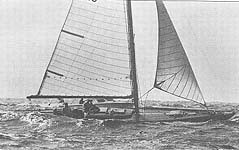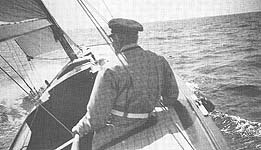|
|
Text und Fotos: Chris Ennals
|
| Those of us who have experienced H.M. King Olav under full sail in his dark green painted - the Anker colour - 8m R SIRA, often in winds which would make others reef once if not twice, will never forget that marvellous sight. SIRA was perhaps the most beautifully designed boat ever to come from Johan Anker’s drawing board - the summit of his long experience. But even at the age of 67 Anker was still eager to experiment with new ideas and gain greater speed from refining the shape of the hull. Luckily for him, he always had a nose for business and seemed to find a willing syndicate amongst his rich friends to order his boats. This time, for the season 1938, Crown-Prince Olav, Georg von Erpecom, Anders Jahre, Jacob Kjøde and Thomas Olsen all clubbed together to order a new eight metre, which right from the start was given the name SIRA (which means "Sire", a courteous form of address in old Norwegian, if the name is not from the river in West Norway called Sira). SIRA’s main specifications are: Length overall: 14.70 m Length at waterline: 9.76 m Beam: 2.44 m Draught: 2.20 m Sail area: 75.90 sq. m. The background for the new order was as follows: In 1937 the "old" Anker 8-metre from 1930, SILJA, a silver medal winner in the 1936 Olympics at Kiel, finally capitulated to the Swedish YVONNE in the Kattegat Cup. The Royal Norwegian Yacht Club (KNS) had managed to win this trophy more often than not in a competition originally between Denmark, Norway and Sweden, but in recent years the sole challenge had come from the Royal Swedish Yacht Club in Gothenburg. A new eight would have to win back the cup for Norway. SIRA was not the only newcomer in the season of 1938. Bjarne Aas, Anker’s rival down at Fredrikstad, had received an order from the Bergen sailor Nordahl Wallem; this new eight was named ANNE SOPHIE. But in the selection races for the Kattegat Cup, SIRA, with Anker as helmsman, proved superior in all 5 starts. Anker must have been relieved, because his last eight metre, VIKING, had not performed satisfactorily in the 1936 selection races for the Olympics. SIRA, the challenger down in Gothenburg, faced ALBATROSS, also a new boat, designed by Tore Holm. ALBATROSS was faster in sidewind and running downwind, but SIRA was far superior when running on a tack, so that Anker, again at the helm, with his sons Erik and Christian in the crew, won three races in a row and thus could take home the trophy once again to KNS. The last time Anker had personally won the cup was as far back as 1906, with BRAND 2, so over 30 years later he must have treasured this particular victory. In the KNS autumn regatta, Crown-Prince Olav tried out SIRA himself, and won over SILJA and FENRIS; a notice in SEILAS early in 1939 informed its readers that the Crown Prince had now become the owner of SIRA. After the first season, the syndicate members had drawn lots; the winner of the lottery could then take over the boat. The actual winner seems to have arranged things so that SIRA was presented to the Crown Prince, and Olav thought he had won! Be that as it may, Crown-Prince Olav had a busy early summer schedule of official duties in 1939, comprising a tour of the United States with Crown-Princess Martha from April- July. In his absence, it was arranged that Anker would sail the boat. For the season 1939, yet another 8-metre, FRØYA, had been produced by Bjarne Aas, this time for Olaf Ditlev-Simonsen, who had been at the helm on SILJA in the 1936 Olympics. For 1940 the sailing Olympics were scheduled for Helsinki; this explains the high level of sporting activity throughout this summer, in spite of the dark war clouds which menaced. There was always the hope that the cataclysm could be averted, at least for Scandinavia, with its strong tradition of neutrality which had kept this area of Europe out of WW I. Yet again in the Kattegat Cup, Johan Anker with SIRA defeated ALBATROSS, this time with a new helmsman, George Lindahl, over three races in succession. Especially the first race was exciting; SIRA’s spinnaker collapsed just before the finishing line, but the momentum carried SIRA over the line a head in front of the Swedish boat, coming up fast from behind. In varying winds, strong the second day, and weak the third day, SIRA won convincingly. The Swedes would have to find another boat; she came in the shape of SVANEVIT–Swanwhite. Directly following the Kattegat Cup, Fredrikstad Sailing Club (near Hankø) arranged a two-day sailing event. Besides the Scandinavians, France, Germany, Italy and Great Britain had sent representatives to compete in the various classes. In the 8-metre class, FRØYA and ANNE SOPHIE joined SIRA in the fight against ALBATROSS. On the first day ALBATROSS won a convincing victory, with SIRA in second place 5 minutes behind, but on the second day Anker sailed up against the wind and passed both ALBATROSS and FRØYA, the leader, to snatch the victory. In the Hankø regatta, the third event to take place in quick succession that week, Tore Holm’s new SVANEVIT finally entered the lists, and won two victories during the three day "tournament". Erik Anker was helmsman on board SIRA the first day, sailed brilliantly, and won. The second day, Johan Anker took over SIRA again, but the forestay broke. Nevertheless, he crossed the line second, in front of ALBATROSS. So SIRA won the King’s Cup, set up especially for the event, having one victory and two second places as compared to SVANEVIT’s two victories and a fifth place. It was this cup, taken home by Erik Anker, which later became the SIRA Cup, donated by Erik and (King) Olav in 1983 to the International Eight Metre Association (IEMA) for the best placed 8 built before 1960, in the annual World Cup event. By August 1939, Crown-Prince Olav had returned from the States, and was now eager to represent KNS and Norway in two events at Sandhamn (near Stockholm). In the Coppa d’ Italia, Olav must have needed time to get acclimatized, because SIRA came in second to last. The Swedish ILDERIM, the moral victor of the 1936 Olympics (because of disqualification she was actually fourth) won the Coppa for the second year running. An interesting collection of eights had assembled at Sandhamn: besides SIRA and ILDERIM, French LE GAULOIS, Italian PINUCCIA and yet another Tore Holm design, ATAIR, competed against each other. In the second event, Crown-Prince Olav acquitted himself honourably, taking a tied third place with ILDERIM. The final sailing event in Norway before the outbreak of war on 1 September was the KNS "autumn" regatta, held 19-20 August. With only a further 10 days to go before Germany invaded Poland, and the subsequent declarations of war, one can perhaps draw a parallel to the famous Europe Week 1914, held just before the outbreak of Armageddon in early August, when the competing sailors were blissful in their ignorance. However, this time, the participants at the KNS autumn event must surely have realized the gravity of the international situation. Olav took part with SIRA, and Martha was on board as crew. The photos of Prince Harald and the Princesses in the cockpit of SIRA were taken about this time - the last precious family moments of the dying sailing season. On 2 October 1939, KNS held a meeting to congratulate those members who had represented their club and country. Commemorative medals were handed out and SIRA’s crew were acclaimed: Johan Anker, Christian Anker, Hans Struksnes, Nordahl Wallem and Fritjof Larsen. At this meeting, Anker made a moving and emotional speech; he jokingly remarked that he intended to keep going for a good while yet. His toast was for Norway to remain a free country, come what may. On 9 April 1940 the calamity of German invasion befell Norway, but the Royal Family escaped from Oslo. At the end of May, Johan Anker met King Haakon and Crown-Prince Olav for the last time in Tromsø, north of Norway, and bade them farewell on 7 June (see the detailed account in English in CLASSIC LINES, November 1997).
During the war and occupation of Norway, SIRA was confiscated by Reichscommissar Terboven for his personal use. In 1980, King Olav was asked by the editor of SEILAS how SIRA had fared. The King replied that professional boatsmen from Hamburg had been put in charge of her maintenance. When His Majesty took possession again of SIRA at the end of the war, the machine gun holders were still on board, but otherwise there was not much damage, luckily. |
Anmerkung zum "Erzgegner" "Svanevit": Sehr geehrte Damen / Herren, |
|
|

